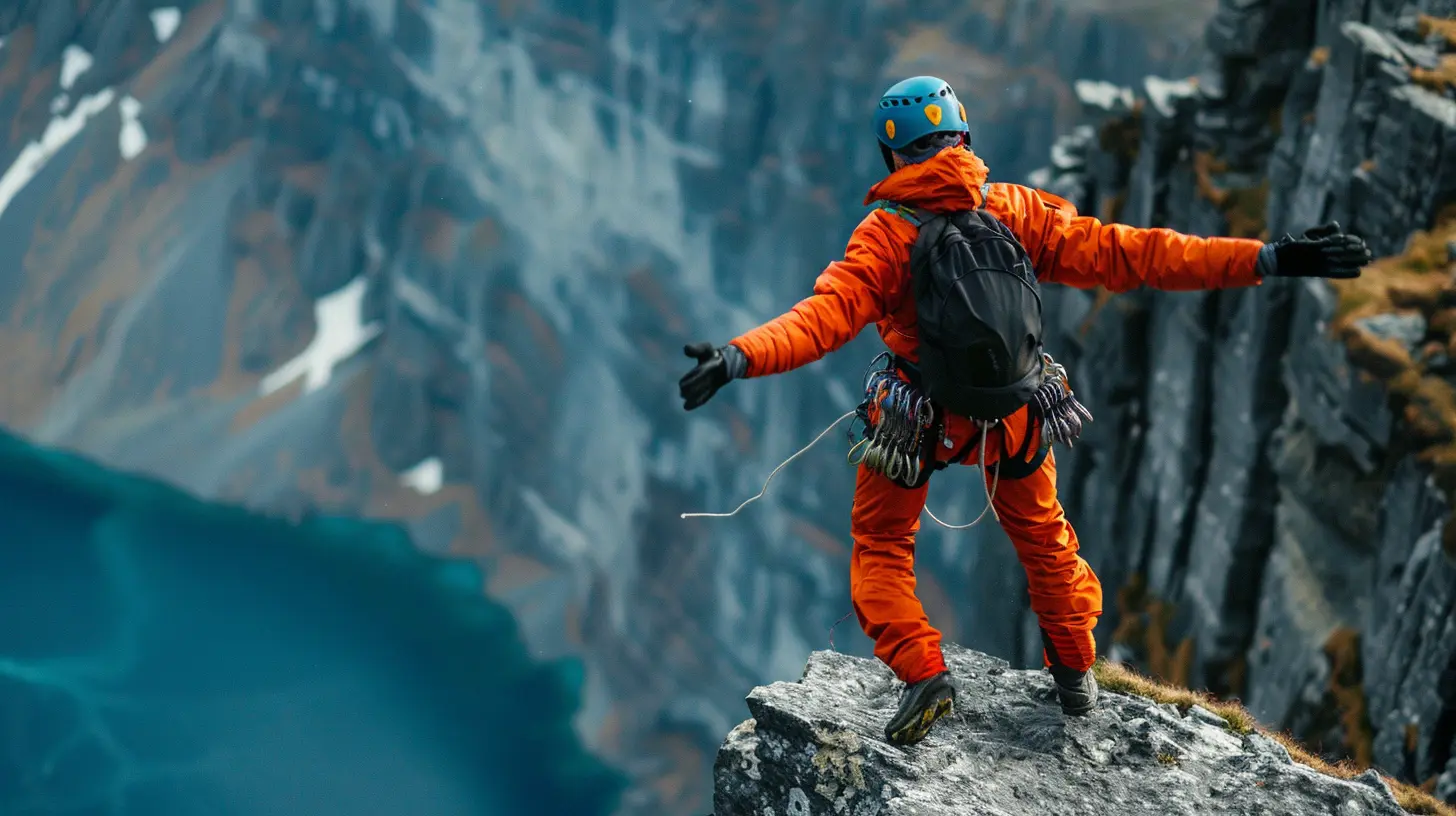Base Jumping: The Wildest Sport You’ve Never Tried
27 October 2025
Ever dreamt of soaring through the sky like a superhero? Imagine standing on the edge of a towering cliff, heart pounding, adrenaline surging, and then... you jump. That’s base jumping—one of the wildest, most extreme sports on the planet.
You’ve probably heard of skydiving, but base jumping takes things to an entirely different level. It’s not just about free-falling from an airplane thousands of feet above ground. Instead, you leap from fixed objects such as cliffs, buildings, bridges, and antennas. Sound crazy? Maybe. But for those who dare to take the plunge, it’s the ultimate thrill.

What Is Base Jumping?
BASE is an acronym that stands for:- Building
- Antenna
- Span (bridges)
- Earth (cliffs and other natural formations)
Unlike skydiving, where you have plenty of altitude and time to open your parachute, base jumping is much riskier. Jumpers have only a few seconds to deploy their parachutes before they hit the ground. There’s no backup parachute, no second chances—just pure adrenaline-fueled skill and precision.

A Brief History of Base Jumping
While humans have dreamt of flying for centuries, modern base jumping started in 1978 when Carl Boenish and his team jumped from El Capitan in Yosemite National Park. They filmed their jumps, introducing the world to the insane beauty of leaping from fixed objects.Since then, the sport has evolved massively. What started as a niche activity among daredevils is now an underground movement with thousands of participants worldwide. From sky-high skyscrapers in Dubai to remote cliffs in Norway, base jumpers are always searching for the next breathtaking jump.

Why Do People Base Jump?
You might be wondering—why would anyone throw themselves off a building or cliff with just a fabric parachute to save them? The answer is simple: pure, unfiltered freedom.1. The Ultimate Adrenaline Rush
There’s no thrill quite like it. The moment you step off the edge, gravity takes over, and for a few heart-stopping seconds, you’re flying. There’s no other feeling quite as raw and intense.2. The Connection With Nature
Some of the most epic base jumps happen in remote, stunning locations. Imagine jumping off a 3,000-foot cliff in the Swiss Alps or soaring past waterfalls in Venezuela. It’s an unmatched way to experience the world's beauty.3. A Test of Courage and Skill
Base jumping isn’t just about the jump—it’s about mastering fear, calculating risk, and honing technical skills. Every jump requires precision, preparation, and a deep understanding of aerodynamics. It’s not just about being brave; it’s about being smart.
How Dangerous Is Base Jumping?
Let’s be real—base jumping isn’t for the faint-hearted. It’s one of the most dangerous extreme sports in the world. With a fatality rate much higher than skydiving, it’s not something you just casually try one weekend.The biggest risks include:
- Low Altitude: There’s very little margin for error. Unlike skydiving, where you have thousands of feet to correct mistakes, base jumpers only have a few hundred feet at best.
- Unpredictable Conditions: Wind gusts, turbulence, or technical malfunctions can be deadly.
- Hard-to-Reach Locations: Many jumps happen in remote areas, making rescue operations nearly impossible if something goes wrong.
That said, experienced jumpers mitigate risks with meticulous planning, skill-building, and the right equipment.
How to Get Started with Base Jumping
If you’re serious about base jumping, you can’t just grab a parachute and jump. Most experienced base jumpers start with skydiving. A lot of them complete at least 200 skydives before even considering a base jump.Step 1: Master Skydiving
You’ll need proper skydiving training to understand freefall dynamics, parachute control, and emergency procedures.Step 2: Train with Experts
Base jumping is not something you learn from YouTube videos. You should train with professionals who can teach you the right techniques, safety measures, and how to read jumping conditions.Step 3: Get the Right Gear
Unlike skydiving parachutes, base jumping rigs are designed for rapid deployment. You’ll need a specialized parachute system, a protective suit, and a helmet with an altimeter.Step 4: Start Small
Your first jumps should be from relatively safe, lower-risk locations like dedicated base jumping sites or bridges with proper landing zones.Step 5: Build Your Experience
The more you jump, the better you’ll get. Eventually, you can progress to bigger and riskier jumps. However, never rush into a jump you’re not ready for—that’s how accidents happen.
The Most Iconic Base Jump Locations in the World
If you’ve ever watched a base jumping video and thought, Where is that?—chances are, it’s one of these legendary locations:1. The Troll Wall, Norway
This is one of the most famous base jumping spots on Earth. The towering rock face provides an incredible freefall experience, but it’s also incredibly dangerous.2. Angel Falls, Venezuela
Jumping next to the world’s tallest waterfall? Unreal. The breathtaking scenery and extreme drop make this a dream jump for many.3. Burj Khalifa, Dubai
The tallest building on the planet has been the backdrop of some of the most insane urban base jumps ever. But you’ll need special permission to pull this one off legally.4. Kjerag, Norway
One of the most beginner-friendly base jumping locations, Kjerag offers multiple exit points with stunning views of Lysefjord.5. Yosemite’s El Capitan, USA
The birthplace of modern base jumping, though it’s currently illegal without a permit. Many jumpers still dream of making this leap.Base Jumping vs. Skydiving: What’s the Difference?
| Feature | Skydiving | Base Jumping ||--------------|------------|---------------|
| Jump Location | Airplane | Fixed Object (building, cliff, bridge) |
| Altitude | 10,000 – 15,000 feet | 200 – 3,000 feet |
| Parachute Deployment | Around 3,000 feet | Almost immediately |
| Risk Level | Moderately high | Extremely high |
| Backup Parachute? | Yes | No |
Is Base Jumping for You?
Let’s be honest—base jumping isn’t for everyone. It’s risky, expensive, and requires serious commitment. But if you’re an adrenaline junkie looking for the ultimate rush, this might be your calling.However, if you’re just looking for a taste of free-fall, skydiving is a much safer and more accessible option. But if you’re ready to push your limits, embrace fear, and fly like a bird, base jumping might just be the wildest adventure of your life.
Would you ever try base jumping? Or does the thought of it make your heart race just sitting there? Either way, there’s no denying that it’s one of the most thrilling sports on the planet.
all images in this post were generated using AI tools
Category:
Adventure SportsAuthor:

Tracie McAdams
Discussion
rate this article
1 comments
Freya Cruz
Ever wondered what it feels like to dance with gravity? Base jumping isn't just a sport; it's an adrenaline-fueled secret waiting to be unraveled. Explore the thrill, if you dare.
October 27, 2025 at 3:54 AM

Tracie McAdams
Absolutely! Base jumping is a breathtaking dance with gravity, offering an adrenaline rush like no other. Are you ready to take the leap?


